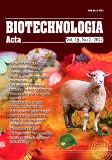ISSN 2410-7751 (друкована версія)
ISSN 2410-776X (электронна версія)

Biotechnologia Acta Т. 15, No. 2 , 2022
P. 74-75, Bibliography 4, Engl.
UDC: 577.112.7
https://doi.org/10.15407/biotech15.02.074
B. V. Zhuravel 2, O. L. Geraschenkо 1, K. O. Tokarchuk 1, I. R. Horak 1, 3, L. B. Drobot1
1Palladin Institute of Biochemistry of the National Academy of Sciences of Ukraine, Kyiv
2Taras Shevchenko National University, Ukraine, Kyiv
3 Masaryk University, Brno, Czech Republic
The purpose of this study was to test the hypothesis that Ruk/CIN85 overexpression/knockdown in melanoma cells may be involved in the regulation of EMT.
Materials and methods. The mouse melanoma cell line B16-F10 and its sublines with up-/down-regulation of Ruk/CIN85 (generated early using lentiviral technology) were used as a model for research. Melanoma cells were cultured in the complete RPMI 1610 medium under standard conditions. Proliferative activity of the cells was estimated using the MTT-test, and cell migratory potential was studied by the wound-healing assay. The data obtained were analyzed with parametric Student`s t-test. Results were expressed as mean ± SEM and significance was set at P<0.05.
Results and Discussion. Cutaneous melanoma genesis is a multi-step process initiated by the transformation of a normal melanocyte following an oncogenic insult. Due to the transcriptome and metabolome reprogramming in the course of EMT, transformed melanoma cells change their phenotype and acquire increased proliferative rate, cell motility, invasiveness, and metastatic potential. According to the data obtained, overexpression of Ruk/CIN85 in B16 mouse melanoma cells (subclones Up7 and Up21) led to an increase in their proliferative activity by 1,6 and 1,8 times, respectively, at 24th hour in comparison with control Mock cells. At the 48th hour, when the cells reached confluence, the cell viability of subclones did not differ from the control ones. No statistically significant changes in the proliferative activity of B16 cells with suppressed expression of the adaptor protein (subclone Down) were found. In accordance with previous data, B16 cells overexpressing Ruk/CIN85 were characterized by strongly increased motility rate (more than twofold for both Up7 and Up21 subclones compared to control Mock cells). At the same time, knockdown of Ruk/CIN85 in B16 cells resulted in a decrease in their migratory activity by about 30%.
Conclusions. All findings obtained demonstrated that the malignancy traits of melanoma B16 cells are inversely modulated upon up- and down-changes in adaptor protein Ruk/CIN85 expression levels suggesting its possible role in the control of EMT.
Key words: melanoma, adaptor proteins, Ruk/CIN85, epithelial-mesenchymal transition, proliferation, migration.
© Інститут біохімії ім. О. В. Палладіна НАН України, 2022
References
1. Langeberg L. K., Scott J. D. Signalling scaffolds and local organization of cellular behaviour. Nature reviews Molecular cell biology. 2015, 16(4), 232?44. https://doi.org/10.1038/nrm3966
2. Tang Y, Durand S, Dalle S, Caramel J. EMT-Inducing Transcription Factors, Drivers of Melanoma Phenotype Switching, and Resistance to Treatment. Cancers (Basel). 2020, 12(8), 2154. https://doi.org/10.3390/cancers12082154
3. Mayevska O, Shuvayeva H, Igumentseva N, Havrylov S, Basaraba O, Bobak Y, Barska M, Volod'ko N, Baranska J, Buchman V, Drobot L. Expression of adaptor protein Ruk/CIN85 isoforms in cell lines of various tissue origins and human melanoma. Exp Oncol. 2006, 28(4), 275?81. PMID: 17285110.
4. Samoylenko A, Vynnytska-Myronovska B, Byts N, Kozlova N, Basaraba O, Pasichnyk G, Palyvoda K, Bobak Y, Barska M, Mayevska O, Rzhepetsky Y, Shuvayeva H, Lyzogubov V, Usenko V, Savran V, Volodko N, Buchman V, Kietzmann T, Drobot L. Increased levels of the HER1 adaptor protein Rukl/CIN85 contribute to breast cancer malignancy. Carcinogenesis. 2012, 33(10), 1976?1984. https://doi.org/10.1093/carcin/bgs228

